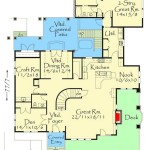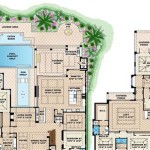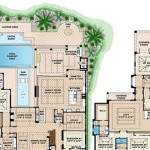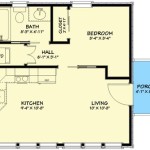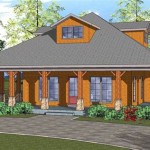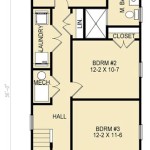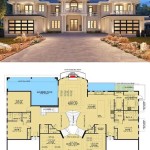House Plans: 4 Bedroom Single Story - Maximizing Space and Comfort
Single-story house plans with four bedrooms offer a blend of accessibility, functionality, and aesthetic appeal, catering to a diverse range of homeowners. These designs are particularly attractive to families with young children, individuals with mobility challenges, and those who prefer the convenience of avoiding stairs. Effective house planning in this category focuses on optimizing space utilization, ensuring comfortable living areas, and incorporating design elements that enhance the overall livability of the home.
A four-bedroom single-story house plan necessitates careful consideration of the desired square footage. A common range is between 1,800 and 2,500 square feet, though larger and smaller designs are certainly possible. The total area will depend on the size of the bedrooms, the configuration of the living areas (open-concept vs. more defined spaces), the inclusion of amenities such as a home office or a formal dining room, and the size of the garage.
Beyond square footage, the layout is paramount. A well-designed plan will strategically position bedrooms, bathrooms, living areas, and the kitchen to maximize flow and functionality. This includes minimizing hallway space, creating clear sightlines, and ensuring that private areas, such as bedrooms, are adequately separated from high-traffic zones.
Key Considerations for Four-Bedroom Single-Story House Plans
Several factors contribute to the success of a four-bedroom single-story house plan. Addressing these early in the design process ensures a home that meets the specific needs and preferences of its inhabitants.
1. Accessibility and Universal Design: The inherent advantage of a single-story design is enhanced accessibility. However, further incorporating universal design principles will greatly benefit occupants of all ages and abilities. This includes wider doorways and hallways to accommodate wheelchairs or walkers, zero-entry thresholds to eliminate trip hazards, and lever-style door handles that are easier to operate. In bathrooms, consider features like grab bars, roll-in showers, and comfort-height toilets.
Beyond physical accessibility, consider intuitive design features. Clear and consistent lighting schemes, easy-to-read signage, and thermostats and other controls that are simple to operate all contribute to a more user-friendly home for everyone.
The placement of essential living areas is also important. For individuals with mobility issues, having the master suite, kitchen, and laundry room on the same side of the house can minimize the distance traveled between these frequently used spaces.
2. Zoning and Privacy: In a four-bedroom house, creating distinct zones is crucial for maintaining privacy and minimizing disruptions. A common approach is to separate the master suite from the other bedrooms, often placing it at one end of the house and the remaining bedrooms at the opposite end or in a separate wing. This layout provides the occupants of the master suite with increased privacy and reduces noise transfer from the other bedrooms.
The placement of the living areas, such as the living room and family room, should also be considered in relation to the bedrooms. Ideally, these activity areas should be located away from the bedrooms to minimize noise disturbances, particularly during evenings and early mornings. The design may incorporate buffer zones, such as hallways or closets, to further isolate the bedrooms from noise.
For homes with young children, placing the secondary bedrooms in closer proximity to the master suite can provide parents with easier access and supervision. However, this arrangement may sacrifice some privacy for the adults. The optimal approach depends on the specific needs and preferences of the family.
3. Natural Light and Ventilation: Maximizing natural light and ventilation is essential for creating a comfortable and healthy living environment. A well-designed house plan will incorporate ample windows, skylights, and strategically placed doors to capture sunlight and promote airflow. Large windows in living areas and bedrooms can enhance the sense of space and bring the outdoors in.
The orientation of the house on the lot plays a significant role in determining the amount of sunlight it receives. In colder climates, orienting the house with the main living areas facing south can maximize solar gain during the winter months, helping to reduce heating costs. In warmer climates, orienting the house to minimize direct sunlight exposure can help to keep it cooler and reduce cooling costs.
Proper ventilation is also crucial for maintaining indoor air quality and preventing moisture buildup. Cross-ventilation, achieved by placing windows or doors on opposite sides of the house, allows for natural airflow. Ceiling fans and strategically placed vents can further enhance ventilation. In kitchens and bathrooms, exhaust fans are essential for removing moisture and odors.
Structural and Layout Considerations
The structural design and layout of a four-bedroom single-story house play a critical role in its overall functionality and aesthetic appeal.
Foundation Type: Common foundation types include slab-on-grade, crawl space, and basement. Slab-on-grade foundations are the most cost-effective option and are suitable for areas with stable soil conditions. Crawl spaces provide access to plumbing and electrical systems and can help to elevate the house above ground level, reducing the risk of moisture damage. Basements offer additional living space, storage, or a combination of both, but they are more expensive to construct and are not suitable for areas with high water tables.
Roof Design: The roof design not only affects the appearance of the house but also its structural integrity and energy efficiency. Gable roofs and hip roofs are both popular choices for single-story houses. Gable roofs are simple and cost-effective to construct, while hip roofs are more resistant to wind and provide better insulation. The roof pitch, or the angle of the roof, also affects its energy efficiency and aesthetic appeal.
Interior Layout: The interior layout should be designed to maximize space utilization and create a comfortable living environment. Open-concept layouts, where the kitchen, dining area, and living room are combined into a single space, are popular for their spaciousness and flexibility. However, they may not be suitable for everyone, as they can lack privacy and noise control. Traditional layouts, where the rooms are more defined, offer greater privacy and noise control but may feel smaller and less open.
The placement of the bedrooms, bathrooms, and living areas should be carefully considered to ensure optimal flow and functionality. The master suite should be located in a private area of the house, away from the other bedrooms and living areas. The bathrooms should be conveniently located near the bedrooms and living areas. The kitchen should be placed near the dining area and should have easy access to the outdoors. Mudrooms are also strategically placed to aid in cleaning before entering the main living spaces.
Material Selection and Construction
The materials chosen for construction significantly impact the durability, energy efficiency, and aesthetic appeal of the house.
Exterior Materials: Common exterior materials include brick, siding, stucco, and stone. Brick is a durable and low-maintenance option that provides excellent insulation. Siding is a more affordable option that comes in a variety of materials, including vinyl, wood, and fiber cement. Stucco is a durable and attractive option that is well-suited for warmer climates. Stone adds a touch of elegance and can be used to create a variety of architectural styles.
Interior Materials: Interior materials should be selected for their durability, aesthetics, and ease of maintenance. Hardwood flooring is a popular choice for its durability and timeless appeal. Tile flooring is a good option for bathrooms and kitchens, as it is waterproof and easy to clean. Carpet is a comfortable and affordable option for bedrooms and living areas. Walls can be painted or wallpapered to add color and personality to the space. Countertops can be made from a variety of materials, including granite, quartz, and laminate.
Energy-Efficient Features: Incorporating energy-efficient features into the design can significantly reduce utility costs and improve the comfort of the home. Energy-efficient windows and doors can help to reduce heat loss in the winter and heat gain in the summer. Insulation can help to keep the house warm in the winter and cool in the summer. Energy-efficient appliances can reduce energy consumption. Solar panels can generate electricity and reduce reliance on fossil fuels.
The construction process should be carefully managed to ensure that the house is built to code and that all work is performed to a high standard. Hiring a qualified and experienced contractor is essential for a successful project.
Ultimately, careful planning, thoughtful design, and proper execution are essential for creating a four-bedroom single-story house that meets the needs and preferences of its occupants while providing a comfortable, functional, and aesthetically pleasing living environment. These considerations coupled with working with qualified professionals ensure a quality project.

Pin Page

Pin Page

Contemporary Plan 4 211 Square Feet Bedrooms 5 Bathrooms 5565 00151

Minimalist Single Story House Plan With Four Bedrooms And Two Bathrooms Cool Concepts

4 Bedroom House Single Y Plans Montgomery Homes 25 Display In Nsw

One Story 4 Bedroom Farm House Style Plan 8817

4 Bedroom House Plan Examples

Four Bedroom One Story House Plan 82055ka Architectural Designs Plans

Archimple 4 Bedroom House Plans Single Story Choose Your Dream Home

House Plan 201024 Single Story 4 Bedrooms 2 5 Bathrooms Floor Instant Custom Plans Service


